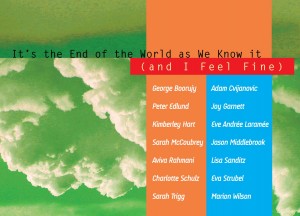It’s the End of the World as We Know it (and I Feel Fine) took place at Ramapo College Gallery in Mahwah NJ from January – March, 2013. The exhibition explored contemporary views of nature and habitat expressed through landscape painting and drawing. The artists included; George Boorujy, Adam Cvijanovic, Peter Edlund, Joy Garnett, Kimberley Hart, Eve Andree Laramee, Sarah McCoubrey, Jason Middlebrook, Aviva Rahmani, Lisa Sanditz, Charlotte Schulz, Eva Struble, Sarah Trigg and Marion Wilson envision the natural world in relationship to pressing environmental issues. Whether imagined or literal, the images in this exhibition directly confront feelings of shock and even despair at the forces of such radical changes taking place on our planet.
Taken from a 1987 song by the band R.E.M., It’s the End of the World as We Know it (and I Feel Fine) this somewhat ironic title suggests the possibility that through awareness, intelligence, compassion and activism, solutions to environmental problems will be found to avoid potentially catastrophic results. The works create new meanings and representations of landscape, which envision specific places from perceptual, historical and conceptual perspectives while at the same time recording the ongoing evolution of human interaction upon the environment. They attempt to meet the challenges of the new ecological imperative by bringing attention to the viewer of the need for protection, preservation and action.
Previously held notions of nature vs. culture have changed for the 21st century and it is increasingly clear that all of life is one interconnected and interdependent system. As such, divisions, dualities, boundaries and geographic borders can be perceived as social constructions -no longer relevant in a global system. Underlying the works in It’s the End of the World as We Know it (and I Feel Fine) is an acute awareness of environmental issues such as climate change, industrial pollution, loss of habitat, consumption of natural resources and human-caused disasters. Some of the artists are committed to merging their art with action and implementation, while others are more interpretive. Using realism, fantasy or process as a source for imagination and transformation, they seek to create an awareness of loss and beauty in the marginal, the overused and the threatened.
Artists often have a prophetic role and throughout history have alerted us to problems that are unforeseen or overlooked. Using realism, fantasy or process as a source for imagination and transformation, they seek to create an awareness of loss and beauty in the marginal, the overused and the threatened.


































